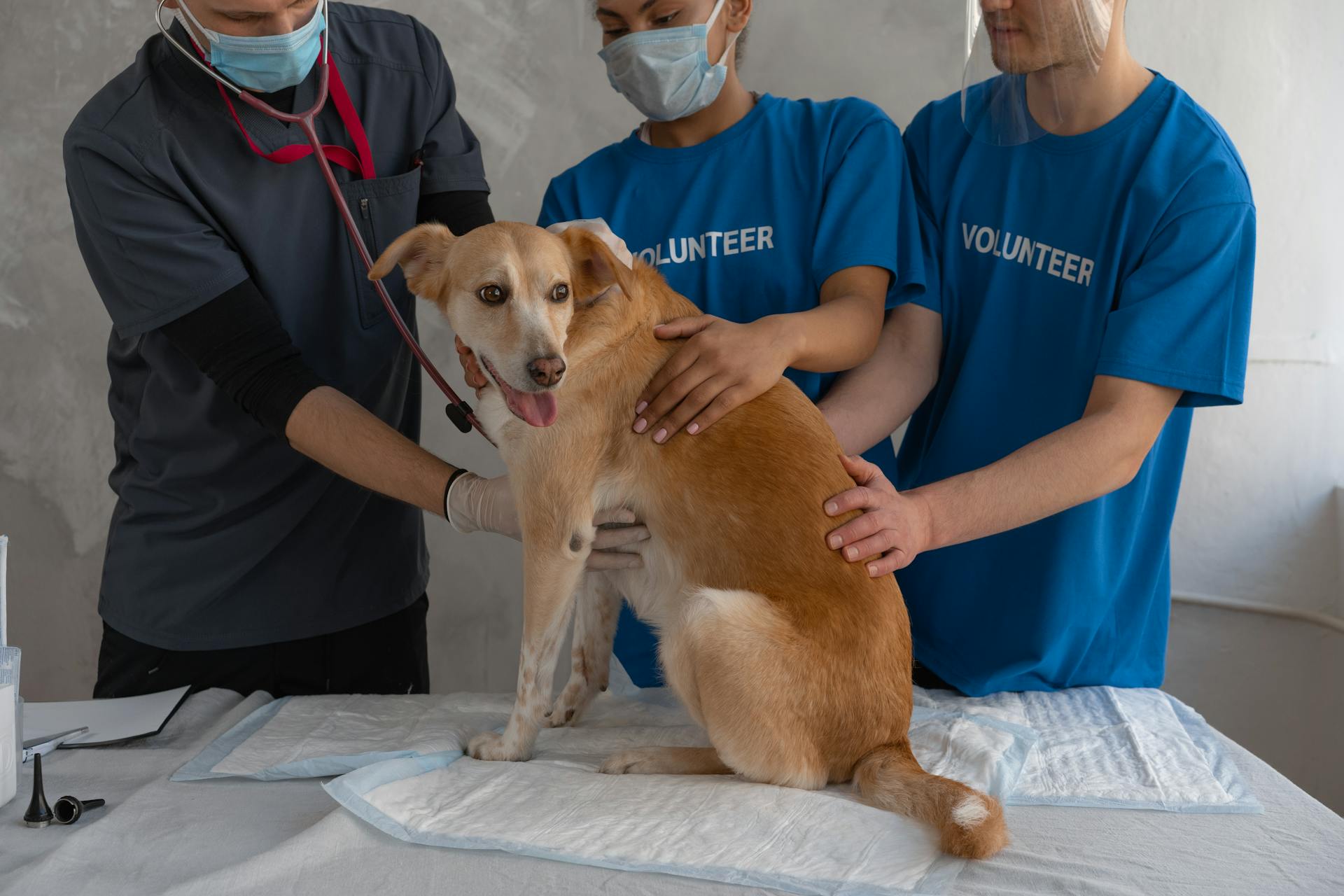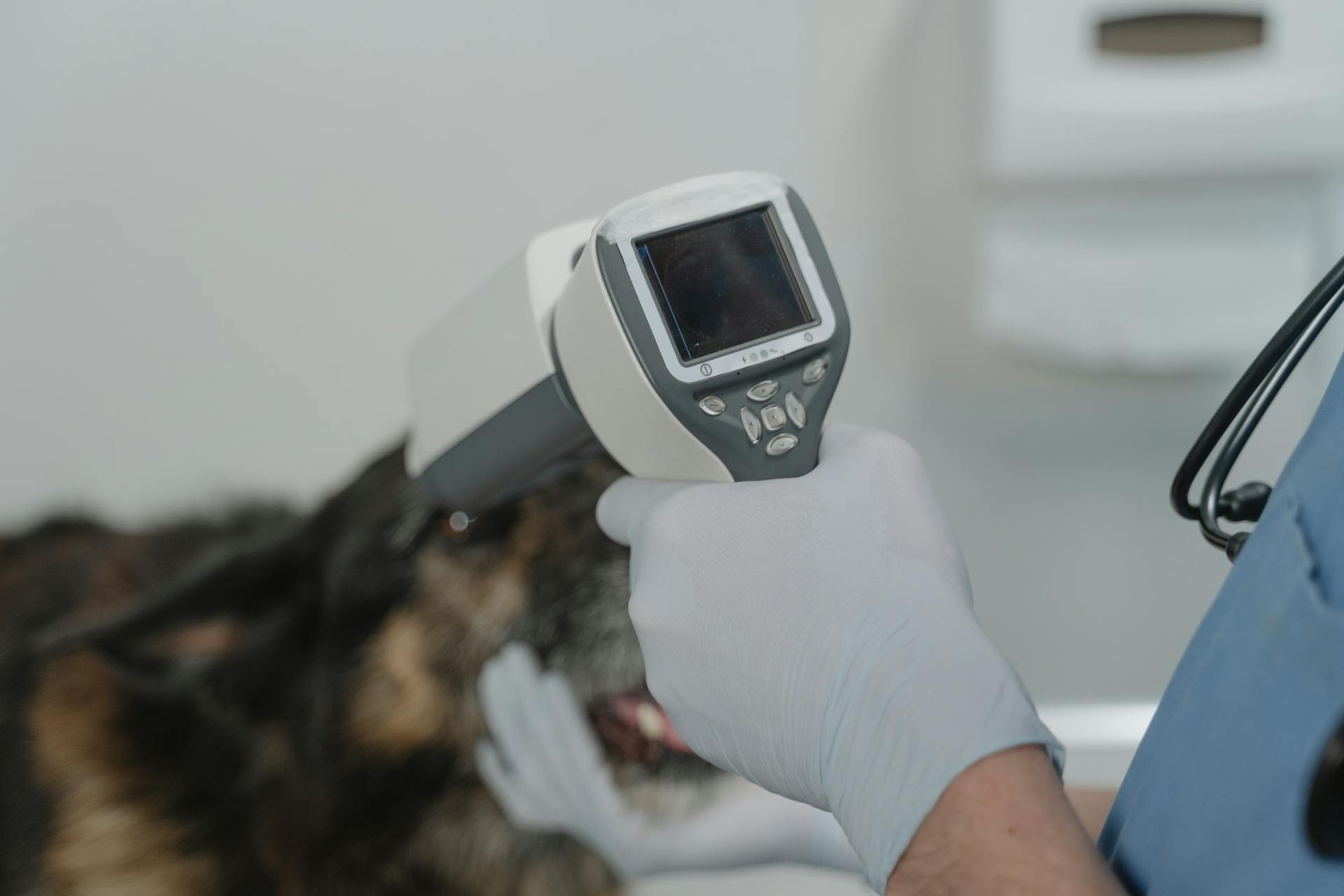
Canine cancer pain can be a challenging and emotional experience for both dogs and their owners.
Dogs with cancer often experience pain due to the tumor itself, as well as from treatments like surgery, chemotherapy, and radiation.
Managing canine cancer pain requires a comprehensive approach that addresses the physical, emotional, and psychological needs of the dog.
Regular exercise, such as short walks, can help alleviate pain and improve a dog's mood.
Management Options
Successful cancer pain management in dogs requires a clear strategy of regular evaluation of the animal's pain and quality of life by the veterinarian and client.
The goal of cancer pain management is to decrease discomfort and provide maintenance of quality of life. Pain management is designed to decrease discomfort and provide maintenance of quality of life.
There are two potential treatment pathways in veterinary oncology: definitive treatment, which aims for long-term control of the cancer and potentially long-term, pain-free survival, and palliative treatment, which aims to relieve cancer pain and slow or minimize the rate of cancer progression.
Additional reading: Canine Mouth Cancer Life Expectancy
Definitive treatment often involves long-term control of the cancer, but may also involve iatrogenic pain as a consequence of treatment.
Palliative treatment, on the other hand, focuses on relieving cancer pain and slowing or minimizing cancer progression.
The type of cancer and the owner's goals for treatment will determine the optimal cancer pain management strategy.
The following pain medications are commonly used in dogs: Rimadyl, Previcox, Galliprant, Tramadol, Buprenorphine, and Gabapentin.
Non-steroidal anti-inflammatory drugs (NSAIDs) are the most popular class of pain medications, and while they aren't technically painkillers, they reduce inflammation, which eases pain.
Opioid-type analgesics are also used to control pain in dogs.
The veterinarian will establish a safe and effective medication protocol for managing the dog's pain.
Here are some common pain management medications:
- Rimadyl
- Previcox
- Galliprant
- Tramadol
- Buprenorphine
- Gabapentin
Palliative surgery and radiation therapy are also options for managing cancer pain in dogs.
Palliative surgery aims to relieve clinical signs of pain and discomfort, while palliative radiation therapy is designed to relieve pain and discomfort by reducing tumor size and inflammation.
These treatment options can be used in combination with medication to provide the best possible pain management for the dog.
Surgical and Radiation Therapies
Surgical removal of the tumor is often the first line of treatment for canine cancer, but it's not always possible. For dogs who can't undergo amputation, radiation is a viable option.
Radiation can be prescribed in two forms: palliative and stereotactic. Palliative radiation aims to alleviate pain and discomfort, while stereotactic radiation is more precise and targeted.
Palliative Surgery
Palliative surgery can be a game-changer for pets with cancer, providing definitive pain relief and restoring quality of life. In some cases, it can even extend life, as seen in dogs with severe bone cancer pain who are often euthanized early to end their suffering.
The first goal of palliative surgery is to decrease the patient's pain, as seen in the case of osteosarcoma where surgery alone provided significant pain relief within 24 hours. This distinction between palliation and definitive treatment is important, as it may involve pursuing chemotherapy to improve long-term survival.
Discover more: Canine Bone Cancer Life Expectancy
To manage post-operative pain, several modalities can be used, including NSAIDs, opioids, gabapentin, and amantadine. These medications are necessary in the postoperative period and may be needed for continued palliation when additional therapies are not pursued.
In some cases, surgical palliation may be considered a viable option, especially when definitive surgery and radiation therapy are not possible. For example, patients with gross soft tissue sarcomas, mast cell tumors, histiocytic sarcomas, and nasal tumors may be good candidates for palliative radiation therapy.
Here are some indications for palliative radiation therapy:
- Patients in which definitive surgery and radiation therapy are not possible
- Patients with gross soft tissue sarcomas, mast cell tumors, histiocytic sarcomas, and nasal tumors
Radiation
Radiation is a treatment option for dogs with cancer that can't undergo amputation. There are two types of radiation: palliative and stereotactic.
Palliative radiation is prescribed for dogs with tumors that can't be removed surgically, either because of the tumor's location or the dog's overall health. This type of radiation is designed to relieve clinical signs of pain and discomfort.
Palliative radiation is especially helpful for relieving pain caused by tumors that invade bone or other areas of the body. This is because radiation can reduce osteolysis, or bone destruction, and decrease tumor size, leading to pain sparing.
For more insights, see: Canine Brain Tumors

Palliative radiation is often used in conjunction with other treatments, such as chemotherapy or surgery, to maximize quality of life for dogs with cancer. Even in incurable cases, palliative radiation can help manage symptoms and improve a dog's comfort and well-being.
In some cases, palliative radiation is used to relieve pain caused by tumors that are too large to be removed surgically. This type of radiation is often used in conjunction with pain management medications to provide the best possible quality of life for the dog.
Anesthetic Induction
Anesthetic induction is a crucial step in any surgical procedure. Propofol is commonly used for induction, and in this case, the patient was induced with 1 mg/kg IV.
The use of propofol-sparing effect, achieved through transdermal fentanyl and acepromazine premedication, is a notable aspect of this induction. This suggests that the combination of these medications can help reduce the amount of propofol needed.
Isoflurane in oxygen is used to maintain anesthesia during the procedure. A circle breathing circuit is used to deliver the anesthetic gases.
Here are the key takeaways from the anesthetic induction process:
- Propofol (1 mg/kg IV) was used for induction
- Transdermal fentanyl and acepromazine premedication achieved a propofol-sparing effect
- Oral tracheal intubation was used for airway management
- Maintenance anesthesia was achieved with isoflurane in oxygen using a circle breathing circuit
Intraoperative
Intraoperative pain control is a critical aspect of surgical procedures. Administering an epidural with bupivacaine (0.5 mg/kg) before incision can be effective.
The combination of ketamine and lidocaine can provide additional pain relief. A ketamine bolus injection of 0.5 mg/kg, followed by an IV CRI of 1–2 mcg/kg/min, can be used in conjunction with a lidocaine bolus injection of 2 mg/kg, followed by an IV CRI of 5–10 mcg/kg/min.
Dexmedetomidine can also be used as an IV CRI, diluted in physiologic saline at 0.5 mcg/kg/hr. This can help control pain and anxiety during the procedure.
Applying lidocaine patches (5%) to the surgical site after skin closure can provide localized pain relief. Two patches may be sufficient for this purpose.
Definitive Chemotherapy
Definitive Chemotherapy is a treatment option that can have some unexpected side effects.
Pain is a possible side effect of chemotherapy in veterinary patients due to drug extravasation and unique drug toxicities.
Hand–foot syndrome, or palmar–plantar dysesthesia, is a type of chemotherapy pain that's well-documented in human patients. It's characterized by diffuse erythema, swelling, and pain of the palmar and plantar surfaces of the hands, feet, or paws.
While uncommon in veterinary medicine, hand–foot syndrome was reported as the dose-limiting toxicity in dogs treated with a liposomal formulation of doxorubicin. This toxicity was reduced by co-administration of pyridoxine.
Chemotherapy pain due to hand–foot syndrome can be managed with the right approach, allowing for fewer treatment delays and dose reductions.
Pain Management Techniques
Pain management is a crucial aspect of canine cancer care. It's essential to understand that pain is a protective mechanism that causes animals to react and move away from the source of the stimulus.
Pain can manifest in various ways, including altered behavior, altered movement or gait, vocalization, and decreased or lack of appetite. Some common signs of pain in dogs include being quieter than normal, avoiding other animals or people, hiding, aggressive behavior, and restlessness.
To manage pain effectively, veterinarians use a combination of medicinal and non-medicinal methods. Medicinal methods include the use of non-steroidal anti-inflammatory drugs (NSAIDs) and opioid-type analgesics to control pain. Non-medicinal methods, on the other hand, can include nerve blocks, which are discussed in more detail in another article.
Here are some common pain medications used in canine cancer pain management, including dosing and frequency of administration:
By understanding these pain management techniques and working closely with a veterinarian, pet owners can help their dogs live more comfortably and maintain a good quality of life.
Non-Narcotic Medications
Non-Narcotic Medications are a common choice for pain management in dogs. They work by reducing inflammation, which in turn eases pain.
One popular class of non-narcotic medications is Non-Steroidal Anti-Inflammatory Drugs (NSAIDs). These medications are often used to control pain in dogs.
NSAIDs are not technically painkillers, but they do a great job of reducing inflammation, which makes them a great option for managing pain. They're often used in conjunction with other pain management techniques.
Some common NSAIDs used in veterinary medicine include Rimadyl, Previcox, and Galliprant. These medications are often used to manage pain in dogs with arthritis or other inflammatory conditions.
Gabapentin and amantadine are also used as part of a pain management protocol. These medications can be effective in managing chronic pain, especially when used in combination with other treatments.
Here are some common non-narcotic medications used for pain management in dogs:
Morphine
Morphine is a well-known drug used to alleviate pain, although it's not approved for veterinary use and can only be prescribed as an "extra-label" drug.
Morphine can be administered by injection, oral tablets, oral solution, and rectal suppositories.
Adverse effects associated with morphine include nausea, vomiting, slowed intestinal movement, constipation, restlessness, low blood pressure, slowed heart rate, slowed breathing, behavior changes, and seizures.
The most profound adverse effects associated with morphine are suppression of breathing and sedation.
Fentanyl
Fentanyl is a potent opiate narcotic analgesic, 100 times as potent as morphine, and is used for pain control in dogs. It's essential to use fentanyl patches with caution and follow strict instructions from a veterinarian.
The patch should be applied to an area of the dog's body that cannot be reached by licking or chewing, and the pet must be prevented from eating the patch. This is crucial because an overdose may result in excessive sedation and depression.
Fentanyl patches are only effective for three days and should be replaced following strict instructions by a veterinarian. Skin sites should be rotated to minimize accumulation in subcutaneous depots, which could result in erratic blood levels.
Common side effects of fentanyl include sleepiness, constipation, dizziness, and nausea. Less common side effects include difficulty breathing, confusion, tremors, vomiting, decreased breathing rate, and lack of coordination.
If your dog has a fever or if you're using direct heat to the area, be cautious when treating them with fentanyl, as increased body temperature can increase the amount of fentanyl absorbed and lead to overdosing.
Here are some key facts to keep in mind when using fentanyl:
- Fentanyl patches are 100 times as potent as morphine.
- The patch should be applied to an area of the dog's body that cannot be reached by licking or chewing.
- Fentanyl patches are only effective for three days.
- Common side effects include sleepiness, constipation, dizziness, and nausea.
- Less common side effects include difficulty breathing, confusion, tremors, vomiting, decreased breathing rate, and lack of coordination.
Nerve Blocks
Nerve blocks are a type of pain management technique that involves injecting analgesic into or around a nerve or into the spinal cord to block pain.
In humans, nerve blocks have been used to relieve cancer pain, and it's worth exploring this option when other pain management techniques are limited.
Nerve blocks have not been used routinely in veterinary patients, but they may be worth considering when other options are exhausted.
One potential benefit of nerve blocks is that they can be used in combination with other pain management techniques, such as opioids and local anesthetics.
Here are some examples of nerve blocks that may be used in veterinary patients:
- Opioids or local anesthetics for regional anesthesia techniques, such as nerve blocks.
- Opioids (with or without ketamine), lidocaine, and dexmedetomidine as intraoperative constant-rate infusions (CRIs).
These nerve block techniques may provide relief from pain in veterinary patients, and it's worth discussing them with a veterinarian to determine the best course of treatment.
Alternative and Natural Remedies
Turkey Tail Mushroom supplements are another natural option for augmenting cancer treatments in dogs. This mushroom has been used medicinally for centuries in many cultures, and there is promising research pointing toward its use in helping animals with cancer.
CBD oil can be an excellent supplemental treatment for dogs undergoing cancer treatment regimens. It can help ease pain, inflammation, anxiety, nausea, and seizures that dogs with cancer may experience.
Pain and inflammation can be side effects of cancer treatment or a symptom of the disease itself. Pain management is almost always a crucial part of treating cancer in dogs.
To address the side effects of cancer and treatments, give your pet CBD consistently. Typically, relief will be best achieved by dosing twice a day.
CBD for dogs is available in many convenient forms, including oils, biscuits, capsules, honey with CBD, and topical ointments. Make sure you buy CBD from a reputable company that conducts and shares third-party lab test results.
Quality pet CBD from a reputable source will be made from the hemp cannabis Sativa plant, which is naturally high in cannabinoids, but has almost no THC and is legal in all states.
Discover more: Turkey Tail Mushroom for Dogs Hemangiosarcoma
Frequently Asked Questions
What to do when cancer pain is unbearable?
If cancer pain is unbearable, talk to your doctor about prescription opioids like morphine or oxycodone, which can provide quick relief but may need to be taken frequently. Your doctor can help determine the best treatment plan for managing your pain.
How do you manage pain in the last stage of cancer?
Pain management in the last stage of cancer typically involves strong pain medicines, such as opioids like morphine, hydromorphone, oxycodone, and fentanyl, to provide relief from severe pain
Sources
- https://todaysveterinarypractice.com/oncology/pathophysiology-assessment-for-managing-cancer-pain-dogs-cats/
- https://bonecancerdogs.org/pain-management-2/
- https://todaysveterinarypractice.com/oncology/definitive-palliative-management-cancer-pain-dogs-cats/
- https://www.allthebestpetcare.com/pet-nutrition/how-cbd-oil-can-help-dogs-with-cancer/
- https://www.animalfarmpethospital.com/services/dogs/pain-management-dogs
Featured Images: pexels.com


